Simple Summary
Insects have different strategies to adapt to environment change and parasites, but the supercooling response of pollinator populations under the biological stress has not been sufficiently investigated. This study assessed the supercooling traits of the solitary bee and its brood parasite. We discovered significant differences in the supercooling points were found between the solitary bee and its brood parasite in the same sex, and also between sexes of same species. The supercooling traits (supercooling points, fresh weight, and fat content) of the two species were significantly positively correlated. Our results suggest that the supercooling points of the solitary bee increase under the biological stress of its brood parasite at a certain level. Overall, the supercooling of pollinator populations varies regularly under brood parasitism pressure.
Abstract
(1) Background: Many insects have evolved different strategies to adapt to subzero temperatures and parasites, but the supercooling response of pollinator populations under the brood parasitism pressure has not been sufficiently investigated. (2) Methods: This study assessed the supercooling traits (supercooling points, fresh weight and fat content) of the solitary bee Osmia excavata Alfken and its brood parasite, Sapyga coma Yasumatsu & Sugihara. We measured 4035 samples (3025 O. excavata and 1010 S. coma, one individual as one sample) and discovered the supercooling traits relations between solitary bee and brood parasite. (3) Results: Significant differences in the supercooling points were found between O. excavata (females: −24.18 (−26.02~−20.07) vs. males: −23.21 (−25.15~−18.65) °C) and S. coma (females: −22.19 (−25.46~−18.38) vs. males: −20.65 (−23.85~−16.15) °C, p < 0.0001) in the same sex, and also between sexes of same species. The two species’ supercooling traits (supercooling points, fresh weight, and fat content) were significantly positively correlated. The supercooling points of the solitary bee varies regularly under brood parasitism pressure. (4) Conclusions: Our study indicates the supercooling traits relationships between a solitary bee and its brood parasite and suggests that the supercooling points of the solitary bee increase under the biological stress of its brood parasite in a certain level.
1. Introduction
Overwintering animals, especially insects, have evolved different strategies to adapt to low-temperature environments in winter [1]. The two main strategies used by insects to survive subzero temperatures included freeze-avoidance and freeze-tolerance [2]. The supercooling point is an overwintering indicator that describes the cold-resistant ability of insects [3]. When the body temperature reaches a specific low temperature, body fluids begin to crystallize. That low temperature is called the supercooling point [1]. Supercooling processes can prevent body fluids from freezing when the temperature is below its equilibrium freezing point. Such supercooling processes occur widely in many types of animals, including insects, amphibians, snails, and reptiles [4,5,6,7]. Insect supercooling occurs during overwintering at subzero temperatures [8]. The overwintering capacity of some insects can be influenced by environmental conditions, including different temperatures, temperature durations, and thermoperiodicity, which is called cold tolerance plasticity [9,10,11]. Supercooling points of insects are affected by multiple intrinsic and extrinsic factors, including the accumulation of glycerol, polyhydric alcohols, trehalose, sorbitol, mannitol, and other low molecular substances, or the reduction of water content and glycogen concentrations [12,13,14]. Additionally, supercooling points may be affected by the insect’s life stage (feeding or non-feeding stage), the ambient temperature, and the individual’s exact instar [7]. Despite recent progress, there is not enough research on supercooling points or overwintering capacity affected by brood parasites.
In a forecast of pollinator responses to climate change, floral host plants (i.e., bottom-up processes) and natural enemies (i.e., top-down forces) both play key roles in pollinator population regulation [15]. Warming temperature on account of climate change has direct and indirect fitness effects on solitary bees [16]. Although insects overwintering [17,18,19,20,21] and host-parasite relations [22,23,24,25,26] have been extensively investigated, the overwintering and supercooling response of pollinator populations under the brood parasitism pressure in cold winter has not been sufficiently investigated.
The goal of this study was to determine the relationship of supercooling traits between the solitary bee Osmia excavata Alfken (Hymenoptera: Megachilidae) [27] and its brood parasite Sapyga coma Yasumatsu & Sugihara (Hymenoptera: Sapygidae) [26]. The solitary bee O. excavata is an important pollinator of fruits and vegetables that is widely distributed in northern China. O. excavata has one generation per year, and their adults feed on nectar and pollen [28]. These bees usually build their nests in reeds or holes in the walls of buildings. Females create multiple earthen cells from mud from the inside out in sequence and lay a single egg in each cell. Pre-reproduction individuals develop alone in their cells, through their egg, larval, pupal, and pre-reproductive adult stages (in cocoons) from April to March. New adults then tear open their cocoons and emerge to mate, feed, and reproduce after making new cells. In fall and winter, farmers collect reeds with cocoons, store them in a refrigerator at 0–4 °C, and use the bees to pollinate apple and cherry orchards in the spring [27]. S. coma is an important brood parasite (kleptoparasite) of O. excavata that lays eggs in unfinished cells of O. excavata while the solitary bee is away [26]. Larvae of S. coma result in the solitary bee’s larvae death. The two species enter diapause as non-emerged adults inside cocoons for a 7-month-overwintering period (September– March) in northern China [26]. In the orchards, the two species overwinter inside thick reeds, which together with their cocoons provide some insulation from cold air and ice present outside reeds. Only a few studies have investigated the supercooling points of Osmia bees or their natural enemies [29,30,31].
Therefore, exploring the potential supercooling response of the solitary bee O. excavata and its brood parasite S. coma provides an opportunity to investigate the differences and correlations of two different species that experience the same cold environment. In this study, we measured the supercooling points and some physiological parameters for several individuals within the species and attempted to find some correlations. Our specific goals of this study are three-fold: (1) we identify associations between the supercooling points of the solitary bee and its brood parasite; (2) we transparentize relationships of physiological parameters between the solitary bee and its brood parasite; (3) we establish whether supercooling responses of the solitary bee vary under the biological stress of its brood parasite.
2. Materials and Methods
2.1. Experimental Insects
The solitary bee O. excavata and its brood parasite S. coma were obtained by collecting reeds, in which they build nests, from fifty villages in the north part of the Jiaodong Peninsula district (35°05′~37°50′ N, 119°16′~122°42′ E), Shandong Province, China. All the O. excavata were the offspring of released individuals under semi-manual management in 2017 spring. Most S. coma were wild populations. Twenty reed tubes full of nested cells were collected from each village in December 2017 and moved to Jinan City, then held indoors from December 2017 to January 2018 for the measurement. About thirty male and thirty female O. excavata adults were selected randomly from those reed tubes collected in each village. All individuals of S. coma from samples were collected for use in experiments because of their lower abundance (0~19.72% of 50 villages). All 4035 insects collected as described above (1507 females and 1518 males of the solitary bee, 527 females and 483 males of the parasite) were tested for supercooling points and physiological parameters, but some invalid data because of damaged samples were removed from the dataset before analysis.
The reed tubes we collected were stored in cardboard boxes near an open window to keep the storage temperature similar to that outside. The mean outside temperature was 2.5 °C in December 2017 and was −0.7 °C in January 2018 (data from Jinan City). After emergence from the ripped cocoons artificially (with scissors), insects were promptly weighed to obtain their fresh weight before the activities and defecation inside the laboratory of which the constant temperature is 23~26 °C, and each individual was then transferred into a refrigerator in 4 °C for 24 h before the determination of the supercooling point. We made sure all the samples were measured and stored in a same way throughout the whole experiment.
2.2. Measurement of Supercooling Points in Our Test Insects
The supercooling points we measured were determined at the Institute of Plant Protection, Shandong Academy of Agricultural Sciences. The supercooling determinator (SUN-II intelligent insect-SCP determinator, SUN Company, Jinan, China) was used to determinate the supercooling point (SCP) and the freezing point (FZP) of each individual. The sampled insects were fixed to the probes of the supercooling determinator using parafilm. Since the supercooling determinator has twenty probes, a group of nineteen samples and one blank control were assessed at one time. Each group, with the probes attached, was placed in a −80 °C freezer. Insects body temperature began to be recorded before being placed in the freezer and recorded 1.6 s apart by the determinator. Each group was recorded at the same time. Temperature recording continued until there were no further rises in temperature.
2.3. Measurement of Body Weight, Water Content, and Fat Content
The fresh body weight (abbreviated as FW) and the dry body weight (abbreviated as DW) were measured with an analytical balance (BSA224S analytical balance, Sartorius Group, Beijing, China). Fresh body weight was determined upon emergence artificially (dissecting the cocoons with scissors to get the unbroken individuals) before defecation. After use in measurement of supercooling points (SCPs) and other variables, each individual was put into a drying oven at 60 °C for 72 h and then weighed to determine the dry weight (abbreviated as DW).
After measuring each individual’s dry weight (DW), we measured the lean dry weight (abbreviated as LDW) as follows. We added 2 mL of a 2:1 mixture of chloroform and methanol, then grounded the insect into a homogenate. The homogenate was centrifuged for 10 min (2600 g), and then the supernatant was removed. This procedure was repeated a second time using the residue. The final residue after this second cycle was put in a drying oven for 72 h at 60 °C, and weighed to determine the constant weight, namely the lean dry weight (LDW) [8,32].
Fat content (FC, see Equation (1)) were calculated as below:
FC = DW − LDW,
2.4. Statistical Analyses
The data of the solitary bee O. excavata and its brood parasite S. coma were organized using Microsoft Excel 2019. The comparisons among three or more sets of data were analyzed using the Mann–Whitney test and Kruskal–Wallis test, followed by Dunn’s multiple comparisons test with p < 0.05, while two sets of data were analyzed using Kruskal–Wallis test (two groups) by non-parametric test in Graphpad Prism 8.4.0. The correlations of supercooling points and physiological parameters (body weight and fat content) between O. excavata and S. coma were analyzed using Pearson correlation coefficient with p < 0.05, followed by simple linear regression in Graphpad Prism 8.4.0. We used generalized additive models (GAM) to examine the relations between supercooling points of O. excavata and S. coma parasite ratio, because this allowed us to relax the assumption that changes of supercooling points of O. excavata when the S. coma parasite ratio increased were linear [33]. We modeled the relations by smooth functions through a Gaussian distribution with an identity link (gam () in mgcv, version 1.8-38, Wood, 2021). All the figures were drawn using Adobe Illustrator 2020.
3. Results
3.1. The Supercooling Points of O. excavata and S. coma
Taken together, the results from Figure 1 showed the solitary bee O. excavata had a lower supercooling point than the brood parasite S. coma, and females had a lower supercooling point than males within a species. The supercooling point was significantly lower in O. excavata than in S. coma (Median (first quartile~third quartile): −23.62 (−25.62~−19.60) vs. −21.37 (−24.83~−17.26) °C, p < 0.0001) (Figure 1a). The supercooling point differed significantly between the different sexes (within a species) and between the two species (within the same sex) (H = 176.4, p < 0.0001) (Figure 1b).
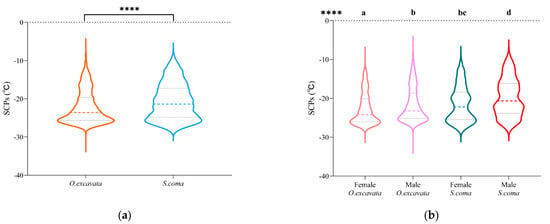
Figure 1.
The distribution and difference of supercooling points (SCPs) between the solitary bee O. excavata and the brood parasite S. coma from 50 villages collected in December 2017, in the north part of the Jiaodong peninsula district, Shandong Province, China. The four asterisks denote significant difference (p < 0.0001) using the Mann-Whitney test (a) and significant difference (p < 0.0001) using the Kruskal-Wallis test (b). Bars with different superscripts denote significant differences (p < 0.0001) using Dunn’s multiple comparisons test (b). The dashed lines indicate medians in the middle and quartiles on both sides of the violin plots.
The supercooling point was significantly lower in the female than in the male O. excavata (−24.18 (−26.02~−20.07) vs. −23.21 (−25.15~−18.65) °C, p < 0.0001). The supercooling point was significantly lower in the female than in the male S. coma (−22.19 (−25.46~−18.38) vs. −20.65 (−23.85~−16.15) °C, p < 0.0001). Comparing across species, the supercooling point was significantly lower in the female O. excavata than S. coma (−24.18 (−26.02~−20.07) vs. –22.19 (−25.46~−18.38) °C, p < 0.0001), and, for males, the supercooling point was significantly lower in O. excavata than S. coma (−23.21 (−25.15~−18.65) vs. −20.65 (−23.85~−16.15) °C, p < 0.0001) (Figure 1b).
3.2. Relationship of Supercooling Points between O. excavata and S. coma
Overall, the supercooling points of S. coma and O. excavata were significantly positively correlated (r = 0.4031, p = 0.0041, n = 49) (Figure 2a). The supercooling points of S. coma significantly increased with that of O. excavata increasing (F(1, 47) = 9.120, R2 = 0.1625, p = 0.0041) (Figure 2a). The supercooling points of female S. coma and female O. excavata were not significantly positively correlated (r = 0.1761, p = 0.2260, n = 49) (Figure 2b). The supercooling points of male S. coma and male O. excavata were significantly positively correlated (r = 0.3103, p = 0.0300, n = 49) (Figure 2c). The supercooling points of male S. coma significantly increased with that of male O. excavata increasing (F(1, 47) = 5.008, R2 = 0.09629, p = 0.0300) (Figure 2c).
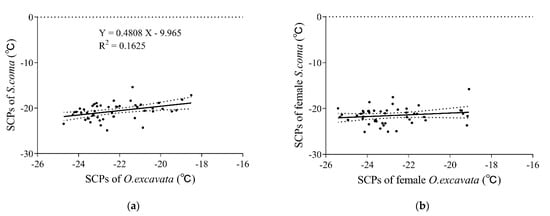
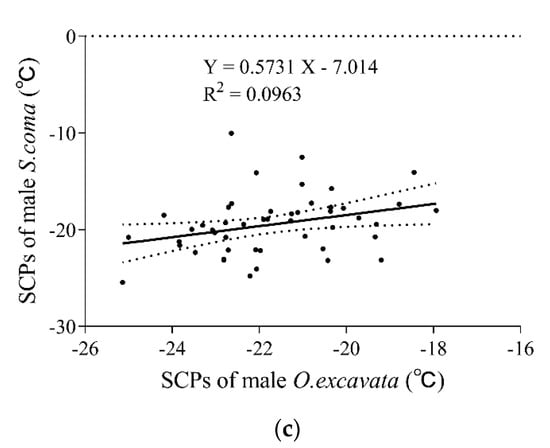
Figure 2.
Influence of SCPs of O. excavata on SCPs of S. coma in (a) general, (b) females, and (c) males. Points show the raw data. Solid lines represent the result of the general linear model, while dashed lines represent the 95% confidence bands. Figures with a regression equation denote a significant (p < 0.05) linear regression and without otherwise.
3.3. Physiological Parameters of the Solitary Bee and Its Brood Parasite
In total, the fresh weights of S. coma and O. excavata were significantly positively correlated (r = 0.4456, p = 0.0106, n = 32) (Figure 3a). The fresh weights of S. coma significantly increased with increasing fresh weights of O. excavata (F(1, 30) = 9.120, R2 = 0.1986, p = 0.0106) (Figure 3a). The fresh weights of female S. coma and female O. excavata were not significantly positively correlated (r = 0.2565, p = 0.1564, n = 32) (Figure 3b). The fresh weights of male S. coma and male O. excavata were significantly positively correlated (r = 0.3787, p = 0.0326, n = 32) (Figure 3c). The fresh weights of male S. coma significantly increased with increasing fresh weights of male O. excavata (F(1, 30) = 5.021, R2 = 0.1434, p = 0.0326) (Figure 3c).
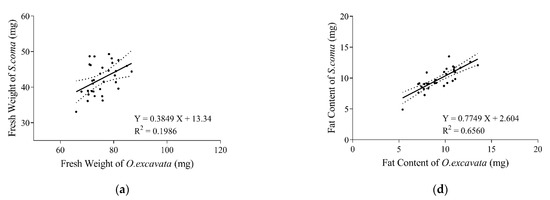
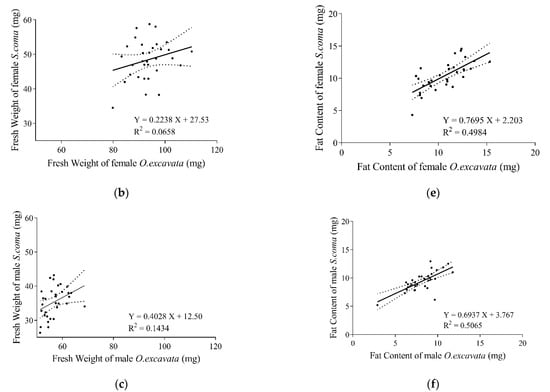
Figure 3.
Influence of fresh weight of O. excavata on fresh weight of S. coma in (a) general, (b) females, and (c) males. Correspondingly, the influence of fat content in (d) general, (e) females, and (f) males, Points show the raw data. Solid lines represent the result of the general linear model, while dashed lines represent the 95%, confidence bands. Figures with a regression equation denote a significant (p < 0.05) linear regression and without otherwise.
Generally, the fat contents of S. coma and O. excavata were significantly positively correlated (r = 0.8100, p < 0.0001, n = 32) (Figure 3d). The fat contents of S. coma significantly increased with that of O. excavata increasing (F(1, 30) = 57.22, R2 = 0.6560, p = < 0.0001) (Figure 3d). The fat contents of female S. coma and female O. excavata were significantly positively correlated (r = 0.7060, p < 0.0001, n = 32) (Figure 3e). The fat contents of male S. coma significantly increased with that of male O. excavata increasing (F(1, 30) = 29.81, R2 = 0.4984, p < 0.0001) (Figure 3e). The fat contents of male S. coma and male O. excavata were significantly positively correlated (r = 0.7117, p < 0.0001, n = 32) (Figure 3f). The fat contents of male S. coma significantly increased with that of male O. excavata increasing (F(1, 30) = 30.79, R2 = 0.5065, p < 0.0001) (Figure 3f).
3.4. Relationship between Parasite Ratio and Supercooling Points of O. excavata
Generalized additive model results showed a significant affected by parasite ratio to supercooling points of O. excavata (Figure 4). In total, the supercooling points of O. excavata and parasite ratio were significantly positively correlated (r = 0.0551, p = 0.0027, n = 2966). The supercooling points of O. excavata were non-linearly related to the parasite ratio. The GAM model explained 2.58% of the R2, and 2.86% of the deviance (p < 0.001). The supercooling points of O. excavata was in a fluctuant downward trend slightly before a parasite ratio of approximately 0.14, then obviously increased with a parasite ratio of approximately 0.14 (Figure 4a).
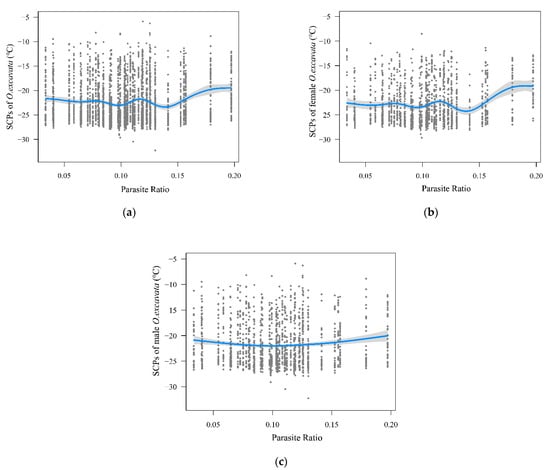
Figure 4.
Influence of parasite ratio on SCPs of O. excavata in (a) general, (b) females, and (c) males. Points show the raw data. Blue lines represent the result of the generalized additive model. The shaded areas represent the 95% confidence interval.
The supercooling points of female O. excavata and parasite ratios were significantly positively correlated (r = 0.0924, p = 0.0004, n = 1479). The supercooling points of female O. excavata were non-linearly related to parasite ratio. The GAM model explained 4.32% of the R2, and 4.85% of the deviance (p < 0.001). The supercooling points of female O. excavata was in a fluctuant downward trend slightly before a parasite ratio of approximately 0.14, then obviously increased with a parasite ratio of approximately 0.14 (Figure 4b).
The supercooling points of male O. excavata and parasite ratios were not significantly positively correlated (r = 0.0220, p = 0.3962, n = 1487). The supercooling points of male O. excavata were non-linearly related to parasite ratio. The GAM model explained 1.06% of the R2, and 1.24% of the deviance (p = 0.001). The supercooling points of male O. excavata were slightly downward before a parasite ratio of approximately 0.10, then obviously increased with a parasite ratio of approximately 0.10 (Figure 4c).
4. Discussion
In the current study, the interactions of several overwinter parameters between the solitary bee O. excavata and its brood parasite S. coma were found, following the analysis of a large numbers of individuals. Previous research recorded that two other species of Osmia were freeze-avoidance species [34]. We found that, due to its supercooling range, the overwintering strategy of the solitary bee O. excavata might be freeze avoidance. Liu et al. gives the supercooling points of male and female O. excavata as −24.46 °C and −25.02 °C, which is close to our results [35]. Comparing the two species, the supercooling points of O. excavata were significantly lower than those of S. coma. O. excavata might withstand lower ambient temperatures than S. coma with lower supercooling points. This might help O. excavata overcome colder winter. We also observed that the supercooling points of females of O. excavata and S. coma were lower than those of their males, suggesting that males may survive winters less well than females. In trap-nesting Hymenoptera, the parental generation controls the sex ratio of its offspring to adjust the female density to the available level of natural resources [36]. Given that the males’ investment in reproduction is only to mate, while females must also locate suitable nest sites, build nesting structures, and reproduce, lower parental investment in males (smaller body mass) compared to females may be justified [36]. Small body mass typically reduces an individual’s overwintering capability [37].
The supercooling points of S. coma increased with O. excavata increasing (Figure 2). We also found that the fresh weight and fat content of S. coma increased with O. excavata increasing. This may be because S. coma gained all nutrition from O. excavata in the larva period [26]. Solitary bees rely on a fixed energy budget during the overwintering period, during which they consume the nectar and pollen provision as larva from the parental generation [38,39]. Fresh weight [40] and fat content [41] were important physiological parameters of insects in overwintering periods.
Moreover, larger and heavier bees emerged earlier in spring than small and light conspecifics that experienced the same overwintering temperatures, which may increase bee fitness [30]. Larger body mass means greater nutrient reserves, improving survival during cold periods [37]. Our results show reasonably good agreement with these studies. As a kleptoparasite (also as a brood parasite) of O. excavata, S. coma kept a related to but different overwintering characteristic from its host through its evolution over time. Nevertheless, the relationship between supercooling point and these physiological parameters is very complex [42].
The incidence of parasitism was one of the critical restriction factors of reproductive output in solitary bee populations, indicating brood parasites play a key role in population regulation [26,43]. In our study, the supercooling points of O. excavata regular varied with an increasing S. coma parasite ratio in each community (including the two research species) from fifty sites (Figure 4). When the S. coma parasite ratio reached a certain level, the supercooling points of O. excavata stopped the slight fluctuate and obviously increased. In defense of natural enemies, solitary bees have evolved many adaptive traits. An empty cell in front of all brood cells was an effective measure to defend brood parasites [24,44]. Females of solitary bees can adjust the parental investment, which affects offspring size and the overwintering capacity when encountering resource constraints [44]. Because of the plenty of time consumed during O. excavata materials gathering activities [45], parasites might have the opportunity to lay eggs in solitary bee nests [26]. When the S. coma population increases to a certain number, to avoid losing the investment to parasites attacking the open cell, solitary bee females can limit each cell’s provision time [43]. With provision time reducing, nutrition in provision from a parental generation for each cell might decrease, resulting in an increase in the offspring’s supercooling points. Due to long-time absence from the nests [45], female O. excavata may have some opportunities to find the female S. coma in a low density, which may causes a slight fluctuate of supercooling points. When the high density of female S. coma causes a high parasite ratio (approximately >0.14), female O. excavata may have more opportunities to show an activity response, which may cause an increase of the supercooling points. As an overwintering indicator, higher supercooling points always mean worse cold-resistant ability, causing a population instability to the cold temperature [3]. Climate change and temperature increasing in winter may alleviate the population instability of solitary bees under the brood parasitism pressure, but this is a subject for further study.
Our study mainly shows that (1) the supercooling points of the brood parasite vary with the supercooling points of the solitary bee; (2) the physiological parameters relating to supercooling points vary with those of the solitary bee; (3) the supercooling points of the solitary bee increase under the biological stress of its brood parasite at a certain level.
5. Conclusions
Supercooling responses under biological stress of parasitism might exist in other insect species. The underlying reason for the appearance of the response in any particular species is ultimately unclear but is a suitable subject for further study. In the longer run, we believe that the ideas present in this paper may have broader application to explore the host supercooling responses of brood parasitism more deeply.
Author Contributions
Conceptualization, Z.Y. and L.W.; Methodology, F.O.; Software, F.O.; Validation, Z.Y., F.G. and F.O.; Formal Analysis, G.V.P.R.; Investigation, Z.Y. and L.W.; Resources, F.G., J.S., X.M. and Y.X.; Data Curation, Z.Y., G.V.P.R. and S.G.; Writing—Original Draft Preparation, Z.Y. and L.W.; Writing—Review and Editing, Z.Y. and S.G.; Visualization, Z.Y.; Supervision, F.O., X.M. and Y.X.; Project Administration, F.O., J.S. and F.G.; Funding Acquisition, J.S. and F.G. All authors have read and agreed to the published version of the manuscript.
Funding
The authors acknowledge support from the National Key Research and Development Program of China (grants 2017YFD0201000 and 2016YFC0503402) and Strategic Priority Research Program of Chinese Academy of Sciences (Grant No. XDPB16).
Institutional Review Board Statement
Not applicable.
Informed Consent Statement
Not applicable.
Data Availability Statement
The datasets generated during and/or analyzed during the current study are not publicly available due to degree related but are available from the corresponding author on reasonable request.
Acknowledgments
We thank Chunjie Liu for providing experimental sites and insects.
Conflicts of Interest
The authors declare no conflict of interest.
References
- Lee, R.E.; Costanzo, J.P. Biological ice nucleation and ice distribution in cold-hardy ectothermic animals. Annu. Rev. Physiol. 1998, 60, 55–72. [Google Scholar] [CrossRef]
- Duman, J.G.; Wu, D.W.; Xu, L.; Tursman, D.; Olsen, T.M. Adaptations of Insects to Subzero Temperatures. Q. Rev. Biol. 1991, 66, 387–410. [Google Scholar] [CrossRef]
- Van Damme, V.; Berkvens, N.; Moerkens, R.; Berckmoes, E.; Wittemans, L.; De Vis, R.; Casteels, H.; Tirry, L.; De Clercq, P. Overwintering potential of the invasive leafminer Tuta absoluta (Meyrick) (Lepidoptera: Gelechiidae) as a pest in greenhouse tomato production in Western Europe. J. Pest Sci. 2015, 88, 533–541. [Google Scholar] [CrossRef]
- Costanzo, J.P.; Iverson, J.B.; Wright, M.F.; Lee, R.E. Cold Hardiness and Overwintering Strategies of Hatchlings in an Assemblage of Northern Turtles. Ecology 1995, 76, 1772–1785. [Google Scholar] [CrossRef]
- Costanzo, J.P.; Lee, R.E.; Ultsch, G.R. Physiological ecology of overwintering in hatchling turtles. J. Exp. Zool. Part A Ecol. Integr. Physiol. 2008, 309, 297–379. [Google Scholar] [CrossRef]
- Nicolai, A.; Vernon, P.; Lee, M.; Ansart, A.; Charrier, M. Supercooling ability in two populations of the land snail Helix pomatia (Gastropoda: Helicidae) and ice-nucleating activity of gut bacteria. Cryobiology 2005, 50, 48–57. [Google Scholar] [CrossRef]
- Sømme, L. Supercooling and winter survival in terrestrial arthropods. Comp. Biochem. Physiol. Part A Physiol. 1982, 73, 519–543. [Google Scholar] [CrossRef]
- Ouyang, F.; Liu, Z.; Yin, J.; Su, J.; Wang, C.; Ge, F. Effects of transgenic Bt cotton on overwintering characteristics and survival of Helicoverpa armigera. J. Insect Physiol. 2011, 57, 153–160. [Google Scholar] [CrossRef]
- Jakobs, R.; Gariepy, T.D.; Sinclair, B.J. Adult plasticity of cold tolerance in a continental-temperate population of Drosophila suzukii. J. Insect Physiol. 2015, 79, 1–9. [Google Scholar] [CrossRef]
- Vesala, L.; Hoikkala, A. Effects of photoperiodically induced reproductive diapause and cold hardening on the cold tolerance of Drosophila montana. J. Insect Physiol. 2011, 57, 46–51. [Google Scholar] [CrossRef]
- Wang, H.-S.; Zhou, C.-S.; Guo, W.; Kang, L. Thermoperiodic acclimations enhance cold hardiness of the eggs of the migratory locust. Cryobiology 2006, 53, 206–217. [Google Scholar] [CrossRef]
- Miller, K. Cold-hardiness strategies of some adult and immature insects overwintering in interior Alaska. Comp. Biochem. Physiol. Part A Physiol. 1982, 73, 595–604. [Google Scholar] [CrossRef]
- Ring, R.A. Freezing-tolerant insects with low supercooling points. Comp. Biochem. Physiol. Part A Physiol. 1982, 73, 605–612. [Google Scholar] [CrossRef]
- Lee, R.E.; Chen, C.-P.; Denlinger, D.L. A Rapid Cold-Hardening Process in Insects. Science 1987, 238, 1415–1417. [Google Scholar] [CrossRef]
- Forrest, J.R.K.; Chisholm, S.P.M. Direct benefits and indirect costs of warm temperatures for high-elevation populations of a solitary bee. Ecology 2017, 98, 359–369. [Google Scholar] [CrossRef]
- Zaragoza-Trello, C.; Vilà, M.; Bartomeus, I. Interaction between warming and landscape foraging resource availability on solitary bee reproduction. J. Anim. Ecol. 2021, 90, 2536–2546. [Google Scholar] [CrossRef]
- Marais, E.; Chown, S.L. Beneficial acclimation and the Bogert effect. Ecol. Lett. 2008, 11, 1027–1036. [Google Scholar] [CrossRef]
- Schebeck, M.; Hansen, E.M.; Schopf, A.; Ragland, G.J.; Stauffer, C.; Bentz, B.J. Diapause and overwintering of two spruce bark beetle species. Physiol. Entomol. 2017, 42, 200–210. [Google Scholar] [CrossRef]
- De Majo, M.S.; Zanotti, G.; Campos, R.E.; Fischer, S. Effects of Constant and Fluctuating Low Temperatures on the Development of Aedes aegypti (Diptera: Culicidae) from a Temperate Region. J. Med. Entomol. 2019, 56, 1661–1668. [Google Scholar] [CrossRef]
- Singh, K.P.; Kochar, E.; Prasad, N.G. Egg Viability, Mating Frequency and Male Mating Ability Evolve in Populations of Drosophila melanogaster Selected for Resistance to Cold Shock. PLoS ONE 2015, 10, e0129992. [Google Scholar] [CrossRef]
- Barat, M.; Vernon, P.; Tarayre, M.; Atlan, A. Overwintering strategy of two weevils infesting three gorse species: When cold hardiness meets plant-insect interactions. J. Insect Physiol. 2010, 56, 170–177. [Google Scholar] [CrossRef]
- Torchio, P.F.; Bosch, J. Biology of Tricrania stansburyi, a Meloid Beetle Cleptoparasite of the Bee Osmia lignaria propinqua (Hymenoptera: Megachilidae). Ann. Entomol. Soc. Am. 1992, 85, 713–721. [Google Scholar] [CrossRef]
- Seidelmann, K. The function of the vestibulum in nests of a solitary stem-nesting bee, Osmia rufa (L.). Apidologie 1999, 30, 19–29. [Google Scholar] [CrossRef][Green Version]
- Münster-Swendsen, M.; Calabuig, I. Interaction between the solitary bee Chelostoma florisomne and its nest parasite Sapyga clavicornis—Empty cells reduce the impact of parasites. Ecol. Entomol. 2000, 25, 63–70. [Google Scholar] [CrossRef]
- Groulx, A.F.; Forrest, J.R.K. Nesting aggregation as a predictor of brood parasitism in mason bees (Osmia spp.). Ecol. Entomol. 2018, 43, 182–191. [Google Scholar] [CrossRef]
- Liu, L.; Li, L.; Li, C.; Yuan, R.; Yu, Y.; Men, X.; Ye, B. Population investigation and restriction factors analyses of Osmia excavata Alfken in Jiaodong. Apicult. China 2018, 69, 68–71. (In Chinese) [Google Scholar]
- Wei, S.-G.; Wang, R.; Smirle, M.J.; Xu, H.-L. Release of Osmia excavata and Osmia jacoti (Hymenoptera: Megachilidae) for apple pollination. Can. Entomol. 2002, 134, 369–380. [Google Scholar] [CrossRef]
- Lu, H.; Dou, F.; Hao, Y.; Li, Y.; Zhang, K.; Zhang, H.; Zhou, Z.; Zhu, C.; Huang, D.; Luo, A. Metabarcoding Analysis of Pollen Species Foraged by Osmia excavata Alfken (Hymenoptera: Megachilidae) in China. Front. Ecol. Evol. 2021, 9. [Google Scholar] [CrossRef]
- Strachecka, A.; Chobotow, J.; Paleolog, J.; Łoś, A.; Schulz, M.; Teper, D.; Kucharczyk, H.; Grzybek, M. Insights into the biochemical defence and methylation of the solitary bee Osmia rufa L.: A foundation for examining eusociality development. PLoS ONE 2017, 12, e0176539. [Google Scholar] [CrossRef] [PubMed]
- Schenk, M.; Mitesser, O.; Hovestadt, T.; Holzschuh, A. Overwintering temperature and body condition shift emergence dates of spring-emerging solitary bees. PeerJ 2018, 6, e4721. [Google Scholar] [CrossRef]
- Slominski, A.H.; Burkle, L.A. Solitary Bee Life History Traits and Sex Mediate Responses to Manipulated Seasonal Temperatures and Season Length. Front. Ecol. Evol. 2019, 7, 314. [Google Scholar] [CrossRef]
- Folch, J.; Lees, M.; Sloane Stanley, G.H. A simple method for the isolation and purification of total lipides from animal tissues. J. Biol. Chem. 1957, 226, 497–509. [Google Scholar] [CrossRef]
- Simpson, G.L. Modelling Palaeoecological Time Series Using Generalised Additive Models. Front. Ecol. Evol. 2018, 6, 149. [Google Scholar] [CrossRef]
- Krunić, M.; Stanisavljević, L. Supercooling points and diapause termination in overwintering adults of orchard bees Osmia cornuta and O. rufa (Hymenoptera: Megachilidae). Bull. Entomol. Res. 2006, 96, 323–326. [Google Scholar] [CrossRef]
- Liu, C.; Bu, H.D.; Feng, Z.L.; Gu, G.J.; Zhang, W.J.; Cao, Y.; Zhao, D.Y. Relationship between physiological indicators and cold resistance on fruit pollinators Osmia excavata Alfken. Heilongjiang Agric. Sci. 2016, 2, 72–76. [Google Scholar]
- Polidori, C.; Boesi, R.; Borsato, W. Few, small, and male: Multiple effects of reduced nest space on the offspring of the solitary wasp, Euodynerus (Pareuodynerus) posticus (Hymenoptera: Vespidae). Comptes Rendus Biol. 2011, 334, 50–60. [Google Scholar] [CrossRef]
- Hahn, D.A.; Denlinger, D.L. Meeting the energetic demands of insect diapause: Nutrient storage and utilization. J. Insect Physiol. 2007, 53, 760–773. [Google Scholar] [CrossRef] [PubMed]
- Slominski, A.H.; Burkle, L.A. Asynchrony between solitary bee emergence and flower availability reduces flower visitation rate and may affect offspring size. Basic Appl. Ecol. 2021, 56, 345–357. [Google Scholar] [CrossRef]
- Torchio, P.F. In-Nest Biologies and Development of Immature Stages of Three Osmia Species (Hymenoptera: Megachilidae). Ann. Entomol. Soc. Am. 1989, 82, 599–615. [Google Scholar] [CrossRef]
- Hahn, D.A.; Martin, A.R.; Porter, S.D. Body size, but not cooling rate, affects supercooling points in the red imported fire ant, Solenopsis invicta. Environ. Entomol. 2008, 37, 1074–1080. [Google Scholar] [CrossRef]
- Rozsypal, J.; Koštál, V.; Berková, P.; Zahradníčková, H.; Šimek, P. Seasonal changes in the composition of storage and membrane lipids in overwintering larvae of the codling moth, Cydia pomonella. J. Therm. Biol. 2014, 45, 124–133. [Google Scholar] [CrossRef] [PubMed]
- Xu, S.; Wang, M.-L.; Ding, N.; Ma, W.-H.; Li, Y.-N.; Lei, C.-L.; Wang, X.-P. Relationships between body weight of overwintering larvae and supercooling capacity; diapause intensity and post-diapause reproductive potential in Chilo suppressalis Walker. J. Insect Physiol. 2011, 57, 653–659. [Google Scholar] [CrossRef] [PubMed]
- Seidelmann, K.; Ulbrich, K.; Mielenz, N. Conditional sex allocation in the Red Mason bee, Osmia rufa. Behav. Ecol. Sociobiol. 2010, 64, 337–347. [Google Scholar] [CrossRef]
- Tepedino, V.J.; McDonald, L.L.; Rothwell, R. Defense against parasitization in mud-nesting Hymenoptera: Can empty cells increase net reproductive output? Behav. Ecol. Sociobiol. 1979, 6, 99–104. [Google Scholar] [CrossRef]
- McKinney, M.I.; Park, Y.-L. Nesting Activity and Behavior of Osmia cornifrons (Hymenoptera: Megachilidae) Elucidated Using Videography. Psyche J. Entomol. 2012, 2012, 814097. [Google Scholar] [CrossRef]
Publisher’s Note: MDPI stays neutral with regard to jurisdictional claims in published maps and institutional affiliations. |
© 2022 by the authors. Licensee MDPI, Basel, Switzerland. This article is an open access article distributed under the terms and conditions of the Creative Commons Attribution (CC BY) license (https://creativecommons.org/licenses/by/4.0/).